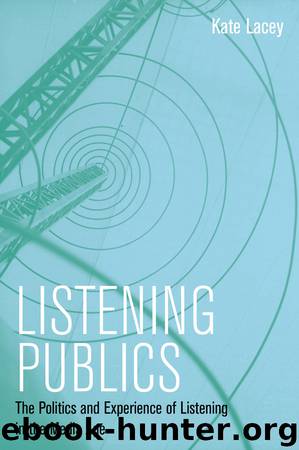Listening Publics by Kate Lacey

Author:Kate Lacey
Language: eng
Format: epub
Publisher: Polity
Published: 2013-01-01T16:00:00+00:00
Ways of Listening
6
The Privatization of the Listening Public
Listening publics in the age before modern media had to assemble in public space. The media of phonography and broadcasting for the first time allowed listening publics to be constituted by citizens in the comfort of their own homes, or within other privatized soundscapes. Although the idea of using either phonographic or radio technology for home entertainment was surprisingly slow to dawn,1 the privatization of the listening public – from the domestication of the gramophone to the ubiquity of personal mobile media – has been a constant if paradoxical motif across the long twentieth century, extending the reach of public listening, but apparently defining it as individuated, dispersed and disempowered.
Privatization is a complex word that at turns encapsulates a spatial metaphor, an economic strategy, a psychological disposition and a withdrawal from the political sphere of public life. Indeed, the idea of the public is necessarily conceived in opposition to the private. And yet this is evidently extremely problematic in the age of modern media. Public and private are not terms that can any longer – if they ever could – be simply opposed to one another, but exist in fluid and mutable relation to each other, producing hybrid forms and spaces that resist simple categorization. In fact, the public/private distinction can be reproduced repeatedly by projecting it onto narrower or broader contexts, or indeed on ‘different social “objects” – activities, identities, institutions, spaces and interactions – that can be further categorized into private and public parts’ (Gal 2002: 81). From different perspectives the same phenomenon can be justifiably described as either public or private, or both/and; for example, a radio station that is described as ‘private’ in economic terms, might be described as belonging to the ‘public’ sphere of communication and paid labour. A ‘private’ opinion expressed on that station becomes ‘public’, although it might be listened to in the privacy of a car on a public highway. The fractal character of the distinction allows us, encourages us, to experience the dichotomy as ‘stable and continuous’ even in the face of all the changes to the content of the distinction. We tend to collapse the embedded distinctions because of the persistence and ubiquity of the central opposition, and so we fall into the trap of thinking there is only one shifting boundary to worry about, as the proliferation of embedded distinctions escape our attention.2
Download
This site does not store any files on its server. We only index and link to content provided by other sites. Please contact the content providers to delete copyright contents if any and email us, we'll remove relevant links or contents immediately.
Cecilia; Or, Memoirs of an Heiress — Volume 1 by Fanny Burney(32491)
Cecilia; Or, Memoirs of an Heiress — Volume 2 by Fanny Burney(31909)
Cecilia; Or, Memoirs of an Heiress — Volume 3 by Fanny Burney(31887)
The Great Music City by Andrea Baker(31754)
We're Going to Need More Wine by Gabrielle Union(19001)
All the Missing Girls by Megan Miranda(15764)
Pimp by Iceberg Slim(14433)
Bombshells: Glamour Girls of a Lifetime by Sullivan Steve(14019)
For the Love of Europe by Rick Steves(13505)
Talking to Strangers by Malcolm Gladwell(13284)
Norse Mythology by Gaiman Neil(13271)
Fifty Shades Freed by E L James(13185)
Mindhunter: Inside the FBI's Elite Serial Crime Unit by John E. Douglas & Mark Olshaker(9259)
Crazy Rich Asians by Kevin Kwan(9216)
The Lost Art of Listening by Michael P. Nichols(7452)
Enlightenment Now: The Case for Reason, Science, Humanism, and Progress by Steven Pinker(7271)
The Four Agreements by Don Miguel Ruiz(6695)
Bad Blood by John Carreyrou(6580)
Weapons of Math Destruction by Cathy O'Neil(6206)
